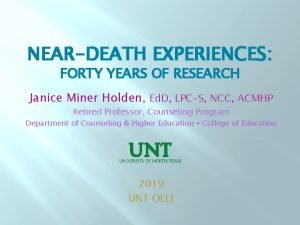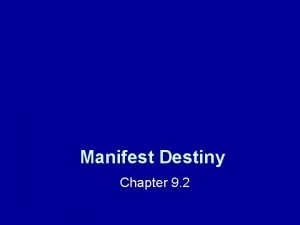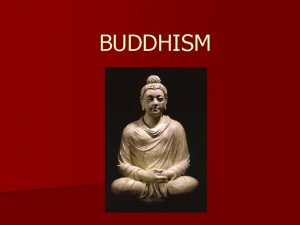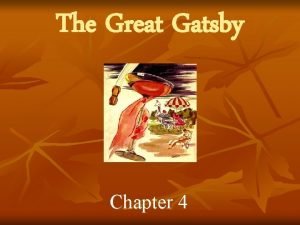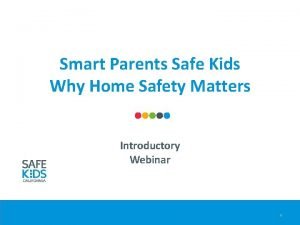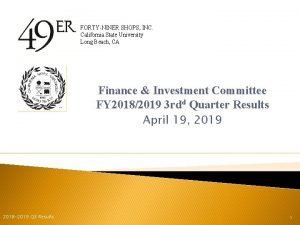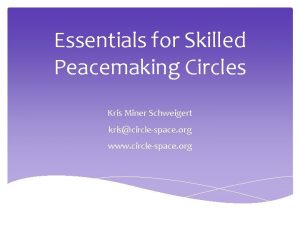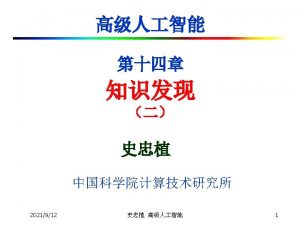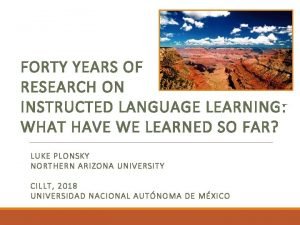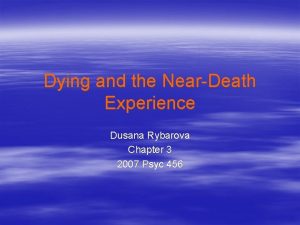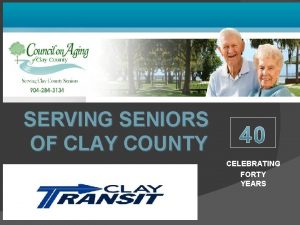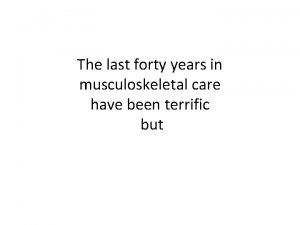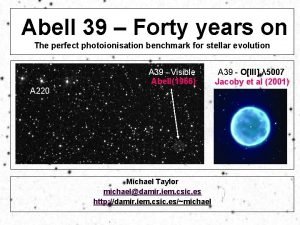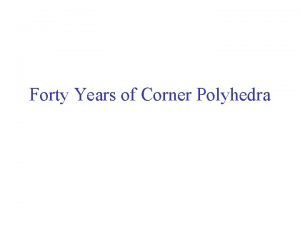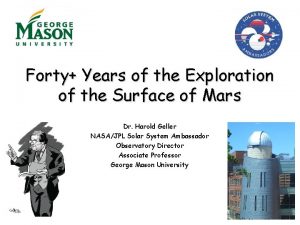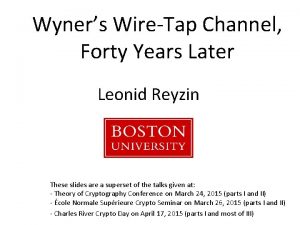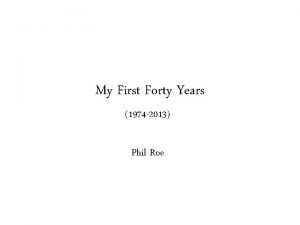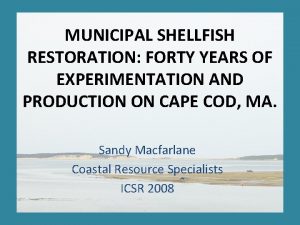NEARDEATH EXPERIENCES FORTY YEARS OF RESEARCH Janice Miner
















- Slides: 16

NEAR-DEATH EXPERIENCES: FORTY YEARS OF RESEARCH Janice Miner Holden, Ed. D, LPC-S, NCC, ACMHP Retired Professor, Counseling Program Department of Counseling & Higher Education College of Education 2019 UNT OLLI

THE FIELD OF NEAR-DEATH STUDIES • • Field formally opened in 1975 with Life After Life by Raymond Moody, MD, Ph. D Descriptions of near-death experiences (NDEs) in Ancient Egyptian, Tibetan, Greek, and Christian texts • More recent Western literature, including Jung’s Memories, Dreams, Reflections • • By 2005, many books and >700 journal articles, incl: • 65 research studies • In US, Europe, Asia, and Australia • Involving more than 3, 500 near-death experiencers (NDErs) • Studying both the experience and aftereffects.

PLEASURABLE WESTERN ADULT NEAR-DEATH EXPERIENCES • • NDEs occur most often during serious illness or injury NDEs include three aspects: • Non-material: peaceful, floating sensation • Material: perceive material world from position outside physical body • Trans-material: perceive and interact with environments and entities not of the material world • Tunnel, void, preternatural environments • Deceased loved ones and spiritual entities; Being of light • Life review

PLEASURABLE WESTERN ADULT NEAR-DEATH EXPERIENCES • • Faces analogy Incidence: 1/5 survivors of close brush with death

PLEASURABLE WESTERN ADULT NEAR-DEATH EXPERIENCES • • • Tricia At interview (2008), mid-30 s, community college English teacher, fully physically functional Grew up in Evangelical church; “pretended” participation At NDE (1994; 14 years before interview) • College student in Austin, TX; ~ 21 years old • Unclear career purpose (copy editor? ); self-centered • Up early to run 10 K; sleepy; car accident • Broken back, leg bones, etc. • Surgery w/ cardiac arrest; 6 months in body cast

AFTEREFFECTS OF PLEASURABLE WESTERN ADULT NDES • • PSPS Psychological aftereffects include: Loss of fear of death • Profound shifts in fundamental values • Increased self-worth and meaning and purpose in life • • Spiritual aftereffects include: Deeper religious/spiritual faith • Paranormal and mystical experiences • • Physical aftereffects include: Changed bodily functions • Malfunction of electrical devices in NDEr’s vicinity • • Social aftereffects include: Relationship stress from NDEr’s psychospiritual shifts • Shift toward service-oriented careers •

DISTRESSING WESTERN NEAR-DEATH EXPERIENCES: FINDING A WAY THROUGH THE ABYSS (Bush, 2017) • • Unlike predominant emotions of pleasurable NDEs, those of distressing NDEs (d. NDEs) include terror, horror, despair. Four types (from most to least frequently reported): • Variation: Same as p. NDE but experienced as unpleasant • Isolation • Torment • Condemnation (1 case) In 20 studies, d. NDE incidence ranged from 0% to 50%. Research has revealed no clear differences between p. NDErs and d. NDErs; it appears anyone can have a d. NDE.

NEAR-DEATH EXPERIENCES OF WESTERN CHILDREN AND TEENS • • Children and teens of all ages have reported NDEs. Children’s and teens’ NDEs are similar to adults’ in: Content • Aftereffects • • • Children’s NDE testimonies can be particularly poignant. Whereas many adult NDErs need focused assistance in integrating the NDE into subsequent life, even more children may need such assistance.

CHARACTERISTICS OF WESTERN NDERS • • • NDEs have been reported by people of every demographic, with no consistent differences; equal opportunity transpersonal experience NDErs reflect the same mental health statuses as the population at large. It is unknown whether possibly greater levels of a few psychological features, such as absorption, preceded the NDEs or resulted from them.

NON-WESTERN NEAR-DEATH EXPERIENCES (Long, 2010) • An analysis of NDEs reported at the Near. Death Experience Research Foundation website revealed contents and aftereffects of NDEs appear to be Universal • With no consistent differences between NDEs of people from various cultures. • • Faces analogy (again)

WORLD RELIGIONS AND NEAR-DEATH EXPERIENCES • • NDE features can be found in the afterlife teachings of the scriptures of, And NDE aftereffects reflect the values of, • Hinduism • Buddhism • Zoroastrianism • Judaism • Christianity • Islam • Bahá’í

VERIDICAL PERCEPTION IN NEAR-DEATH EXPERIENCES • • • In apparently non-physical veridical perception (AVP), NDErs perceive phenomena during their NDEs in material and/or trans-material domains that they could not have known from sensory or rational processes yet that are later corroborated as accurate. • Tricia seeing step-dad vend candy bar Six different controlled studies of AVP in hospitals yielded no cases of AVP. In The Self Does Not Die, over 100 cases of paranormal phenomena during NDEs corroborated by credible 3 rd parties (Rivas, Dirven, & Smit, 2016)

EXPLANATORY MODELS OF NEAR-DEATH EXPERIENCES • • • Scholars have proposed psychological, physiological, and transcendental theories to explain NDEs. Psychological and physiological models fail to account for all features of NDEs and their aftereffects. Mainstream scientists, who believe the brain somehow produces the mind, have not embraced transcendental models that include the contentions: • that mind sometimes functions, often exceptionally well, when brain is disabled, and • that mind is primary and that brain, like a cell phone, receives and transmits mind.

PRACTICAL APPLICATIONS OF RESEARCH ON NEAR-DEATH EXPERIENCES • Practical applications have focused on Clinical considerations • Education • • Clinically, NDErs have reported both helpful and harmful experiences disclosing their NDEs to others • In a study of 88 NDErs reporting on 188 experiences of disclosure (Holden, Kinsey, & Moore, 2014), • On average, positive side of neutral • In approximately 40%of disclosure experiences, NDEr felt harmed – with no difference between medical, mental, social, or spiritual healthcare providers • Disclosure experiences had not improved over 7 decades • Worst if NDEr reported relatively sooner and/or had relatively deeper NDE.

PRACTICAL APPLICATIONS OF RESEARCH ON NEAR-DEATH EXPERIENCES • • Clinicians have generated recommended approaches for healthcare providers to work most effectively with NDErs in the immediate and long-term NDE aftermaths. Clinicians probably less likely to harm if they hold certain knowledge and attitudes about NDEs • • Studies have shown some educational programs effective in improving healthcare professionals’ knowledge and attitudes Knowing about NDEs can be beneficial for non-NDErs in settings such as education and grief counseling.

REFERENCES Bush, N. E. (2017). The Buddha in hell and other alarms: Distressing near-death experiences in perspective. Wilmington, NC: Author. Holden, J. M. (2017). Near-death experiences. In R. D. Foster & J. M. Holden (Eds. ), Connecting soul, spirit, mind, and body: A collection of spiritual and religious perspectives and practices in counseling. Denton, TX: University of North Texas Libraries, and Alexandria, VA: Association for Spiritual, Ethical, and Religious Values in Counseling. Retrieved from http: //www. library. unt. edu/aquiline-books/connecting-008 -3 Holden, J. M. , Greyson, B. , & James, D. (Eds. ). (2009). The handbook of neardeath experiences: Thirty years of investigation. Santa Barbara, CA: Praeger/ABC-CLIO. Holden, J. M. , Kinsey, L. , & Moore, T. R. (2014). Disclosing near-death experiences to professional healthcare providers and non-professionals. Spirituality in Clinical Practice, 1(4), 278 -287. doi: 10. 1037/scp 0000039 Long, J. (2010). Evidence of the afterlife: The science of near-death experiences. New York, NY: Harper. Collins. Rivas, T. , Dirven, A. , & Smit, R. (2016). The self does not die: Verified paranormal phenomena from near-death experiences. Durham, NC: International Association for Near-Death Studies.
 Janice miner holden
Janice miner holden Sheep years to human years
Sheep years to human years 300 solar years to lunar years
300 solar years to lunar years Four score and seven years ago
Four score and seven years ago Ten twenty thirty forty fifty sixty seven
Ten twenty thirty forty fifty sixty seven Reading and writing numbers 2/5
Reading and writing numbers 2/5 Blood of war part 1
Blood of war part 1 Fifty four forty or fight
Fifty four forty or fight How many sects of buddhism
How many sects of buddhism Forty niners apush
Forty niners apush Forty and eight
Forty and eight Ebook aggregators
Ebook aggregators Forty second street cellar
Forty second street cellar Forty two
Forty two Forty niner shops
Forty niner shops Kris miner
Kris miner Meni miner
Meni miner
